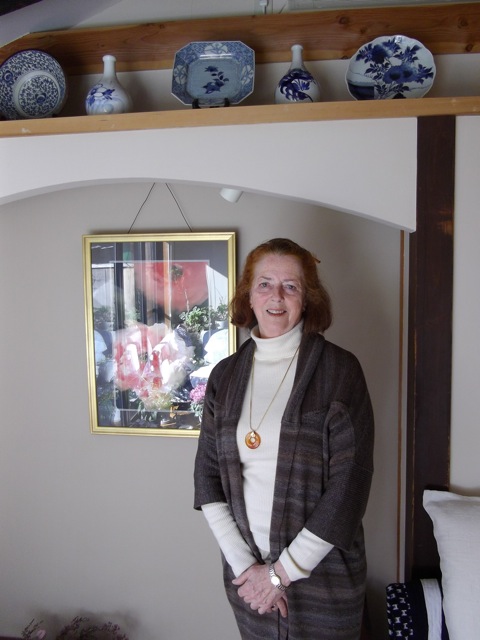April 29, 2015
Interview: Judith Clancy
Judith Clancy on Kyoto’s Gardens
Kyoto Gardens: Masterworks of the Japanese Gardener’s Art. Text by Judith Clancy, photography by Ben Simmons. Tuttle Publishing, 2014. ISBN 978-4-8053-1321-3.
Veteran writer and expert on Kyoto, where she has been a resident and member of the community since 1970, teams up with professional photographer Ben Simmons in this lavishly illustrated introduction to selected gardens in the old city.
Judith tells us:
 My involvement in this volume is totally due to the beautiful photographs that Ben has compiled over many years. Ben never rushes into a place but actually plants himself within the space, the atmosphere, and season-du-jour to really see and record what is before him. There is an intensity within each frame that excites the viewer and inspires me.
My involvement in this volume is totally due to the beautiful photographs that Ben has compiled over many years. Ben never rushes into a place but actually plants himself within the space, the atmosphere, and season-du-jour to really see and record what is before him. There is an intensity within each frame that excites the viewer and inspires me.
I also approach the gardens from an historical perspective, much of that gleaned from Marc Keane’s excellent translation of Sakuteiki, a 1,000-year old treatise on gardening. My personal love of gardens is also related to my involvement with ikebana, which I have been practicing for the past 40 years. The Japanese perspective in art, whether linear or three dimensional, has aided my overall understanding of the genius of landscapes and flower arrangement.
When Ben expressed his hope to collaborate on another book, I was delighted to help—it is a wonderful opportunity to showcase these amazing plots of land, transformed over the centuries into works of art.
Q: In your four decades of living in Kyoto, has anything changed in the attraction these gardens have for you?
JC: In my book Exploring Kyoto I have flower symbols scattered across the pages of each chapter. I wanted to guide visitors without specific interests to go just as their Japanese counterpart would—to see the garden when its best flowers are in season. Unlike out-of-city visitors who only have a few chances to see these gardens, Kyotoites know well the seasonal delights and the reasons for visiting repeatedly. For example, many people will visit Mimurotoji in May to see the azalea and in June to see the hydrangea, so temple gardeners today continue to expand their floral attractions by relandscaping when space becomes available. Besides hanami viewing under the cherries, this custom of “hana-meguri” (following the flowers) is a tiny bit unique to Japan, especially in Kyoto, and over my decades-long residency here it continues to delight me.
Q: The jacket mentions the “class of professional gardeners.” Did you get to know or talk to any of those people while working on this book? Largely invisible in their role, did you find they have qualities that would inspire we translators?
JC: From personal knowledge, the pruning and design techniques they have learned have cost them years of study and practice. One of the first gardeners who worked on my own garden told me of the three years he had spent during his apprenticeship “sitting in a river” (perhaps not literally but as a figure of speech) to understand the flow of water around rocks. If there is anything that could be gleaned from this, I guess it is to keep working at translation until it feels settled and right. Such dedication to one’s craft is truly inspiring.
Q: For the long-time Japanese resident like yourself and many SWET readers, for whom “Japanese gardens” are everywhere, what should we particularly look for as we take visitors to see these sights?
JC: There is so much to say here, but essentially, the very first thing that comes to mind is rock placement. All else is centered on where the rocks are. Even directing a slight curve in a stream—a well-placed rock will not only divert the flow but aerate the water. Another observation is that proportion of planting to rock seems to indicate that less is more. The love of ma, the untouched or open surface, allows the viewer to breathe within the setting, to let the imagination expand. Then there is the aesthetic element of formal→less formal→informal (shin-gyo-so) that determines pathways, borders and plantings. So many aspects converge to create a beautiful landscape and we must recognize the effect of the climate of this humid, almost semi-tropical land that allows flowers to bloom all year round, offering the gardener a infinite palette of choices.
If feeling discouraged, just think of what sitting in a river for three years might be like and learning to observe so carefully and with such precision that the final work never seems contrived or sloppy. I draw inspiration from this when redoing every single sentence until the essence of what I want to say reveals itself. This doesn’t always happen but I try.
Thank you for these further insights. For the work-weary wordsmith, a nearby stroll garden can be a salutary place of repose and replenishment.
